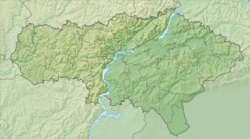| Pudovkino Formation | |
|---|---|
| Stratigraphic range: Campanian ~ | |
| Type | Geological formation |
| Lithology | |
| Primary | Marl |
| Location | |
| Coordinates | 51°30′N46°00′E / 51.5°N 46.0°E |
| Approximate paleocoordinates | 42°48′N40°48′E / 42.8°N 40.8°E |
| Region | Saratov Oblast |
| Country | Russia |
The Pudovkino Formation (Russian: Pudovkino Svita) is a Late Cretaceous (Campanian) geologic formation in Saratov Oblast of European Russia. [1] Pterosaur fossils have been recovered from the marine marls of the formation.

